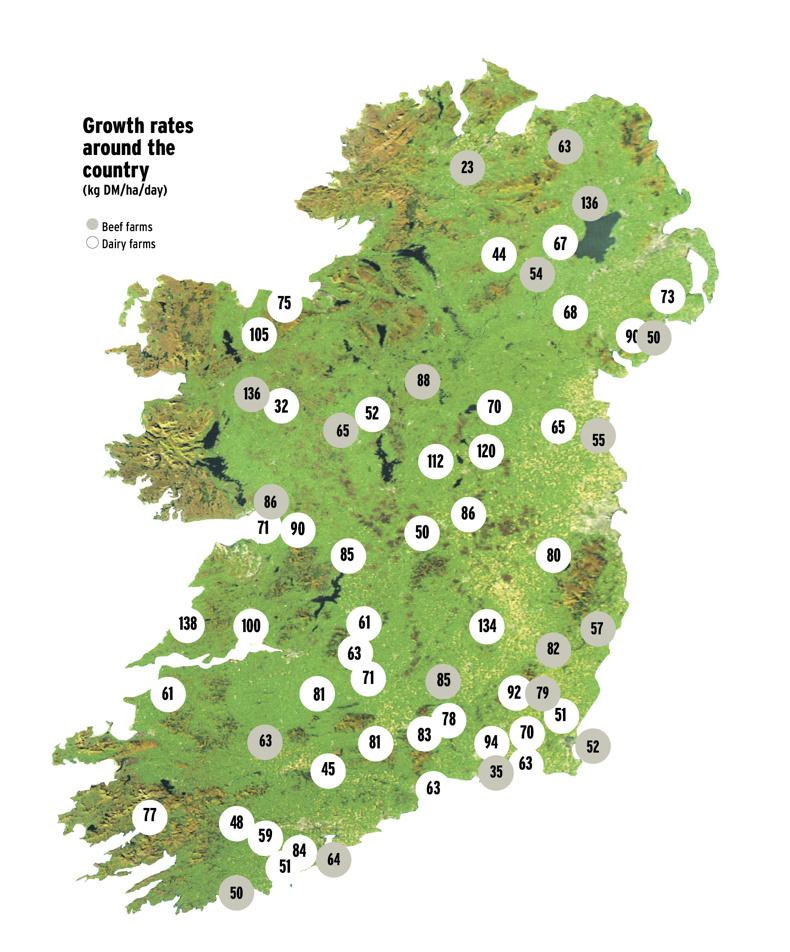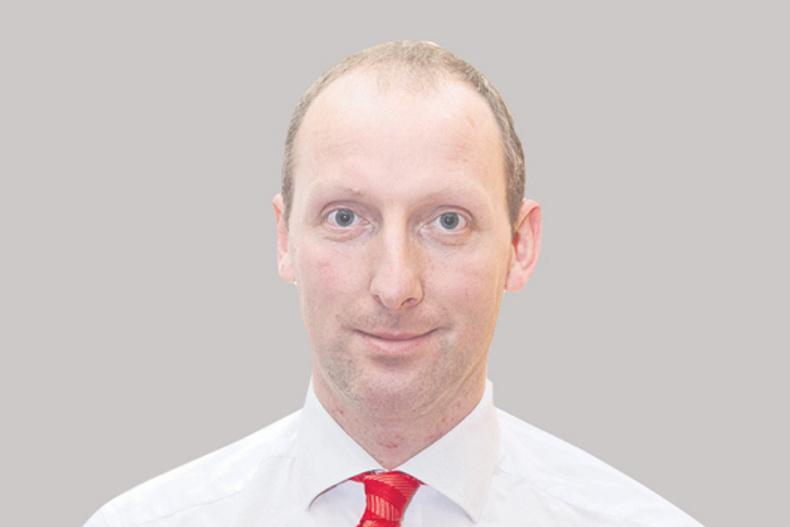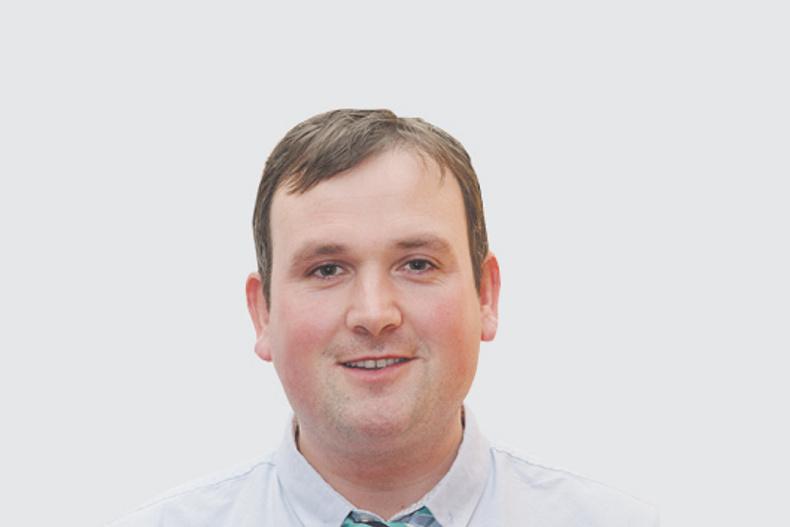Our BETTER beef farms have grown an average of 70kg DM/ha daily in the last week. Intermittent bursts of rain and heat are leading to record grass growth rates on some farms for July, with a number reporting three-figure growth rates.
At the point in the year when our grass growth curve traditionally begins its descent into the back-end, in the short term there are no signs of a reduction in growth. We are in for a warm weekend, particularly in the south and east of the country. Modest rain forecast on Saturday will be concentrated in coastal areas, particularly to the west.
What does this mean for grazing? Business as usual. While the guidelines for July involve a gradual increase in a farm’s grass supply (average farm cover/days ahead), I would not be in any panic to lift a days ahead figure of 10-12 just yet given the conditions at present. In 2016, a late start to grass growth left us chasing our tails for much of the spring and early summer. Then we enjoyed an extended period of good growing and grazing conditions into the autumn and actually ended up producing the same amount of grass as a normal year – a compensatory effect. Looking at the 2017 curve, the pattern at this stage is looking very familiar.
That said, we need to hit our autumn targets for grass and should follow N fertiliser guidelines. While second-cut ground coming back into the rotation will boost supply, we should be getting a bag of CAN/acre across a grazing block in late August as a last fertiliser application. July will be a quiet month for fertiliser on most farms. However, those stocked at 2.5LU/ha or above should be splitting 60 units of N in two or three spreads between late-July and late-September.

Grass growth 70kg DM/ha/day.Growthy weather to continue.No rush to increase farm covers at this point.
Co Clare
System: suckler to store
Soil type: variable
Average farm cover (kg DM/ha): 719
Grass demand (kg DM/ha/day): 34
Growth (kg DM/ha/day): 80
Growth is picking up again and I’ve more paddocks to take out once the weather settles. I’ve also burnt off a paddock for reseeding. The reseeding I carried out eight weeks ago is in great order and I’ve the bulls grazing it at the moment. I’m happy enough with their weights – they’ll be coming up on 12 months in August and they’re creeping close to 500kg at the moment.
I’m gearing up for calving again and cows are being restricted on hay in a bare paddock. They’re not too fat so hopefully there shouldn’t be any issues at calving.
I’ll start building grass from next month on and having more grass in the shoulders of the year is something I hope to achieve over the duration of the programme. I need to lengthen my grazing season at both ends to cut winter feed costs. While it’s easily done in the back end, I need to ensure that I have grass on the farm in the spring. That’s why I’ll begin to build up grass in the coming weeks.

Co Waterford
System: suckler to bull beef
Soil type: variable
Average farm cover (kg DM/ha): 612
Grass demand (kg DM/ha/day): 47
Growth (kg DM/ha/day): 52
As a result of the dry spell, growth rates have slowed due to the lack of moisture in the soil. However, even with the recent poor growth rates, grass is still in plentiful supply due to the fact that I am autumn calving and currently restricting my cow herd. This is to keep them from getting over-fit for calving, which is due to start at the end of the month. Heifers will start a week or so beforehand. All of the cows were given Allsure boluses and an IBR live booster last week. Autumn-born bulls were weighed last week and they have had an average daily gain of 1.27kg/day since turnout.
In the last few weeks, I started to introduce meal into their diet and they are currently on 2kg/day. The heaviest of these bulls will be housed at the end of the month for finishing at U-16 months. All of the youngstock will get a dose this week as some are starting to show signs of worms. This week I plan to power-harrow and reseed 12 acres.

Co Longford
System: suckler to weanling
Soil type: variable
Average farm cover (kg DM/ha): 955
Grass demand (kg DM/ha/day): 40
Growth (kg DM/ha/day): 6 3
My farm cover is higher than it should be but it includes paddocks that, in my head, I have earmarked for removal. I will cut around three acres out when the weather allows – potentially with my second cut, which is ready to take. Fertiliser was spread on it six weeks ago, while the whole farm got a half bag of CAN at the end of June. I also plan to take some bales from a field that was reseeded last year. It’s booming along growth-wise so I fertilised a section of it and will take silage from it a few weeks down the line. The way grass is going here we will have serious fodder reserves this back end, but I am conscious that I need to begin building grass after my second cut comes back into the grazing mix.
Five of the autumn herd have calved, all unassisted. The calves are by my Saler bull and were good and vigorous. As soon as I’m certain that they’ve sucked, they go straight outside. The bull will come away from the spring cows on 20 July.

Co Louth
System: suckler to bull beef
Soil type: free-draining
Average farm cover (kg DM/ha): 1,075
Grass demand (kg DM/ha/day): 59
Growth (kg DM/ha/day): 109
Grass is in good supply here, but when my autumn calvers kick off on 1 August my demand will jump. They’re currently on bare paddocks and beginning to spring up. I put out a strong bag of CAN across the whole farm at the end of June and won’t go again with the spreader until August, after the second cut is in. I hope to get it in the first week of the month – I was slightly late taking a first cut.
The stock bull is still with 14 of the spring herd who haven’t all passed three weeks beyond their last service date. He’ll be coming out very soon. Thankfully, he doesn’t look very busy.
I slaughtered my last six under-16-month bulls a fortnight ago. They averaged 403kg carcase weight and there were four U+ and two U=. However, a number didn’t meet the required 2+ fat score. While I was still relatively happy with the money they came into, I know it could have been better. I didn’t start feeding hard until the beginning of April. I’ll go earlier next year.

Our BETTER beef farms have grown an average of 70kg DM/ha daily in the last week. Intermittent bursts of rain and heat are leading to record grass growth rates on some farms for July, with a number reporting three-figure growth rates.
At the point in the year when our grass growth curve traditionally begins its descent into the back-end, in the short term there are no signs of a reduction in growth. We are in for a warm weekend, particularly in the south and east of the country. Modest rain forecast on Saturday will be concentrated in coastal areas, particularly to the west.
What does this mean for grazing? Business as usual. While the guidelines for July involve a gradual increase in a farm’s grass supply (average farm cover/days ahead), I would not be in any panic to lift a days ahead figure of 10-12 just yet given the conditions at present. In 2016, a late start to grass growth left us chasing our tails for much of the spring and early summer. Then we enjoyed an extended period of good growing and grazing conditions into the autumn and actually ended up producing the same amount of grass as a normal year – a compensatory effect. Looking at the 2017 curve, the pattern at this stage is looking very familiar.
That said, we need to hit our autumn targets for grass and should follow N fertiliser guidelines. While second-cut ground coming back into the rotation will boost supply, we should be getting a bag of CAN/acre across a grazing block in late August as a last fertiliser application. July will be a quiet month for fertiliser on most farms. However, those stocked at 2.5LU/ha or above should be splitting 60 units of N in two or three spreads between late-July and late-September.

Grass growth 70kg DM/ha/day.Growthy weather to continue.No rush to increase farm covers at this point.
Co Clare
System: suckler to store
Soil type: variable
Average farm cover (kg DM/ha): 719
Grass demand (kg DM/ha/day): 34
Growth (kg DM/ha/day): 80
Growth is picking up again and I’ve more paddocks to take out once the weather settles. I’ve also burnt off a paddock for reseeding. The reseeding I carried out eight weeks ago is in great order and I’ve the bulls grazing it at the moment. I’m happy enough with their weights – they’ll be coming up on 12 months in August and they’re creeping close to 500kg at the moment.
I’m gearing up for calving again and cows are being restricted on hay in a bare paddock. They’re not too fat so hopefully there shouldn’t be any issues at calving.
I’ll start building grass from next month on and having more grass in the shoulders of the year is something I hope to achieve over the duration of the programme. I need to lengthen my grazing season at both ends to cut winter feed costs. While it’s easily done in the back end, I need to ensure that I have grass on the farm in the spring. That’s why I’ll begin to build up grass in the coming weeks.

Co Waterford
System: suckler to bull beef
Soil type: variable
Average farm cover (kg DM/ha): 612
Grass demand (kg DM/ha/day): 47
Growth (kg DM/ha/day): 52
As a result of the dry spell, growth rates have slowed due to the lack of moisture in the soil. However, even with the recent poor growth rates, grass is still in plentiful supply due to the fact that I am autumn calving and currently restricting my cow herd. This is to keep them from getting over-fit for calving, which is due to start at the end of the month. Heifers will start a week or so beforehand. All of the cows were given Allsure boluses and an IBR live booster last week. Autumn-born bulls were weighed last week and they have had an average daily gain of 1.27kg/day since turnout.
In the last few weeks, I started to introduce meal into their diet and they are currently on 2kg/day. The heaviest of these bulls will be housed at the end of the month for finishing at U-16 months. All of the youngstock will get a dose this week as some are starting to show signs of worms. This week I plan to power-harrow and reseed 12 acres.

Co Longford
System: suckler to weanling
Soil type: variable
Average farm cover (kg DM/ha): 955
Grass demand (kg DM/ha/day): 40
Growth (kg DM/ha/day): 6 3
My farm cover is higher than it should be but it includes paddocks that, in my head, I have earmarked for removal. I will cut around three acres out when the weather allows – potentially with my second cut, which is ready to take. Fertiliser was spread on it six weeks ago, while the whole farm got a half bag of CAN at the end of June. I also plan to take some bales from a field that was reseeded last year. It’s booming along growth-wise so I fertilised a section of it and will take silage from it a few weeks down the line. The way grass is going here we will have serious fodder reserves this back end, but I am conscious that I need to begin building grass after my second cut comes back into the grazing mix.
Five of the autumn herd have calved, all unassisted. The calves are by my Saler bull and were good and vigorous. As soon as I’m certain that they’ve sucked, they go straight outside. The bull will come away from the spring cows on 20 July.

Co Louth
System: suckler to bull beef
Soil type: free-draining
Average farm cover (kg DM/ha): 1,075
Grass demand (kg DM/ha/day): 59
Growth (kg DM/ha/day): 109
Grass is in good supply here, but when my autumn calvers kick off on 1 August my demand will jump. They’re currently on bare paddocks and beginning to spring up. I put out a strong bag of CAN across the whole farm at the end of June and won’t go again with the spreader until August, after the second cut is in. I hope to get it in the first week of the month – I was slightly late taking a first cut.
The stock bull is still with 14 of the spring herd who haven’t all passed three weeks beyond their last service date. He’ll be coming out very soon. Thankfully, he doesn’t look very busy.
I slaughtered my last six under-16-month bulls a fortnight ago. They averaged 403kg carcase weight and there were four U+ and two U=. However, a number didn’t meet the required 2+ fat score. While I was still relatively happy with the money they came into, I know it could have been better. I didn’t start feeding hard until the beginning of April. I’ll go earlier next year.













 This is a subscriber-only article
This is a subscriber-only article















SHARING OPTIONS: